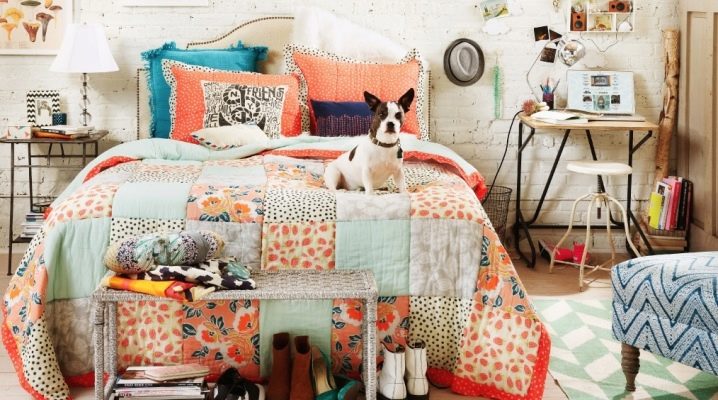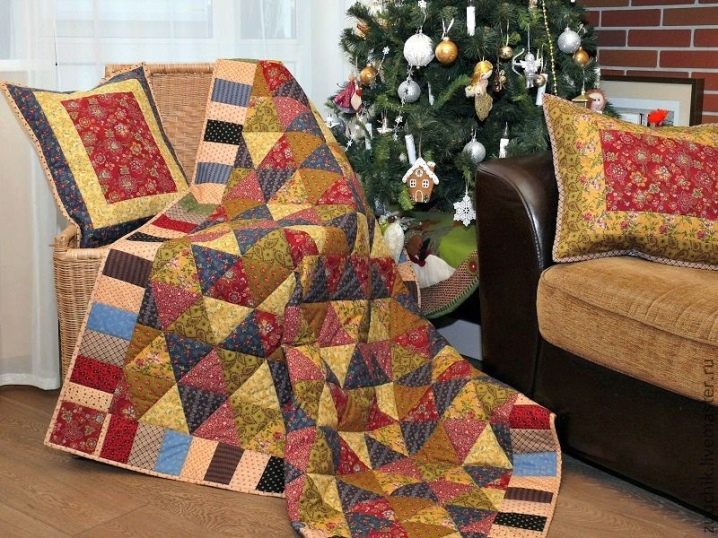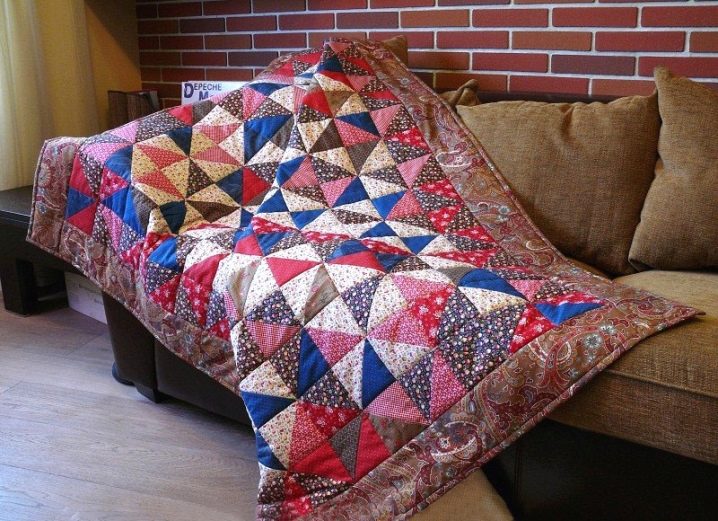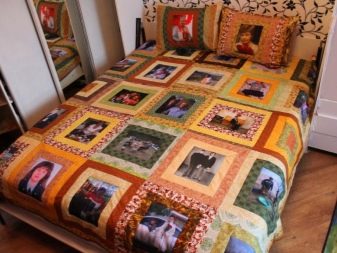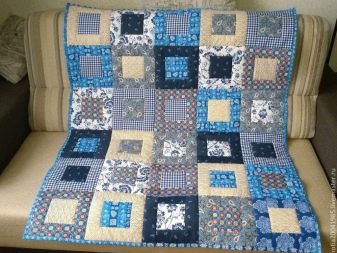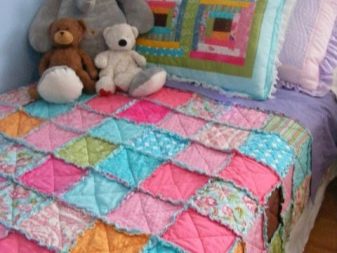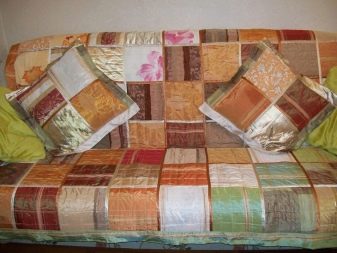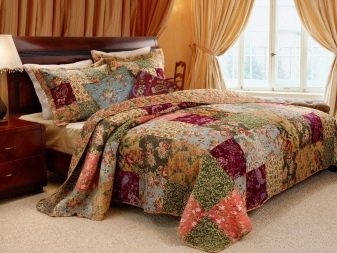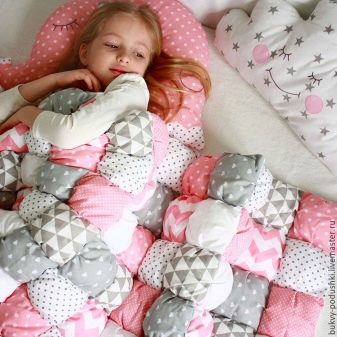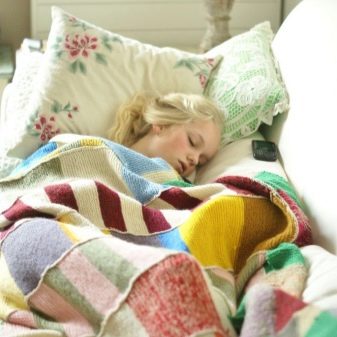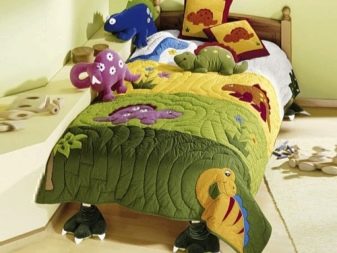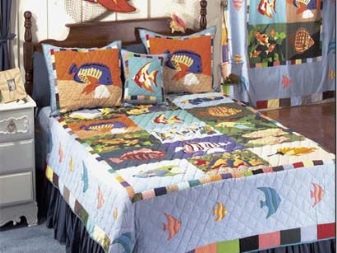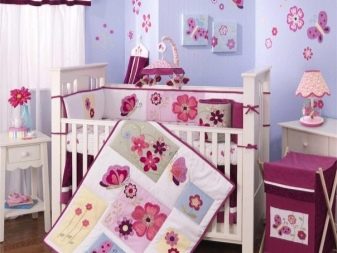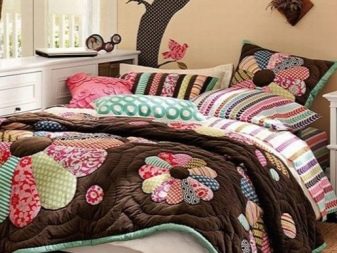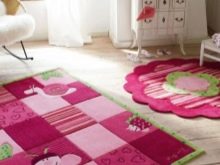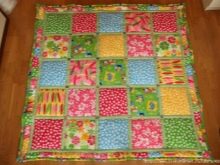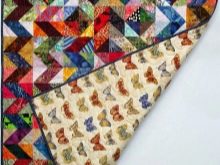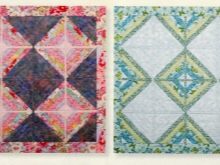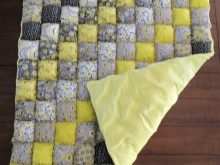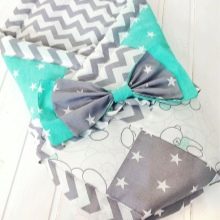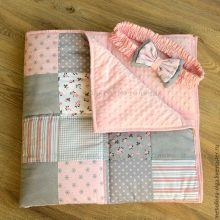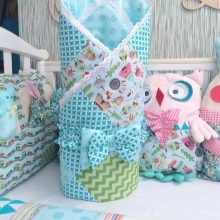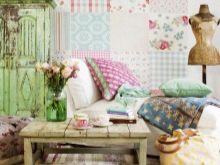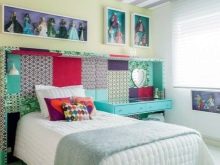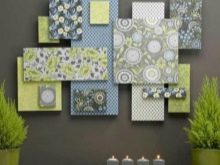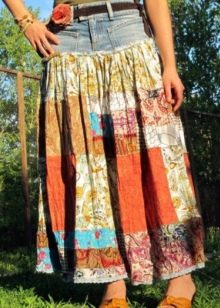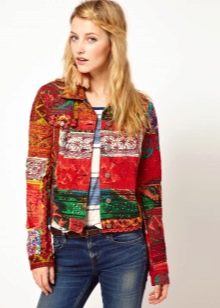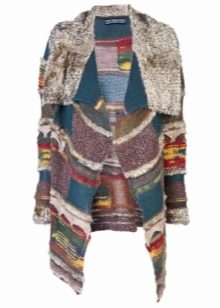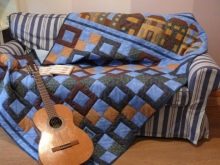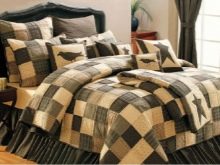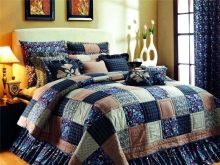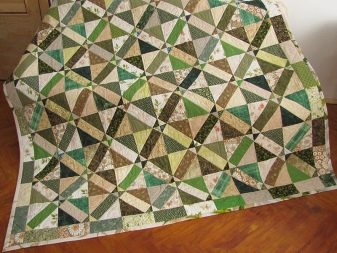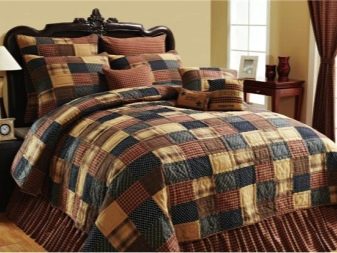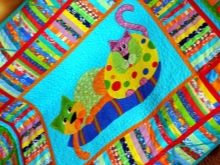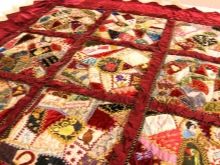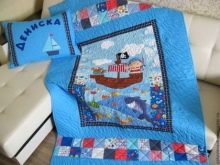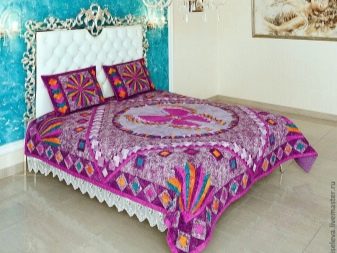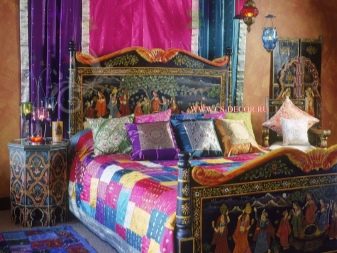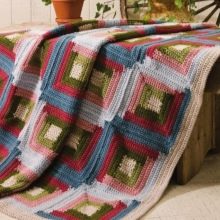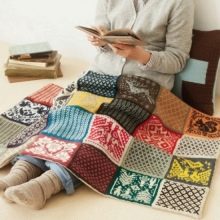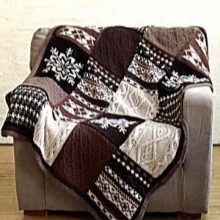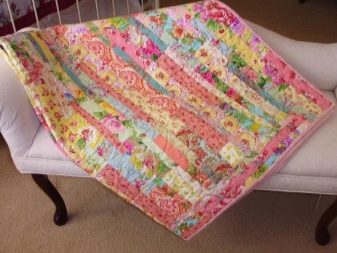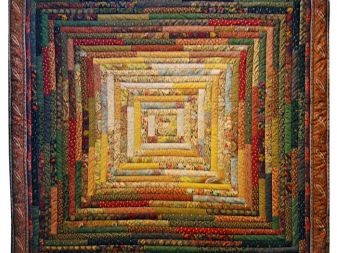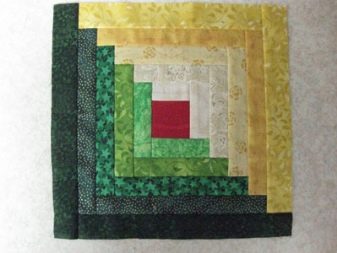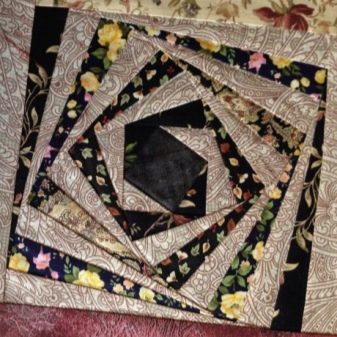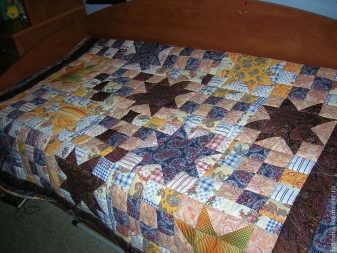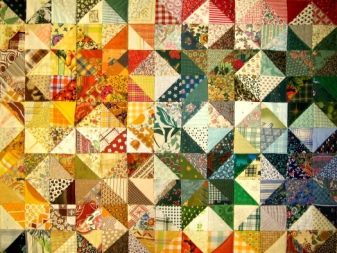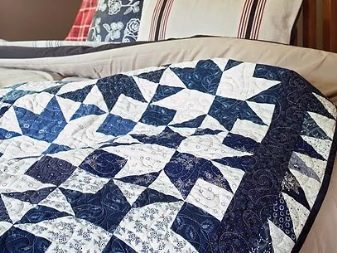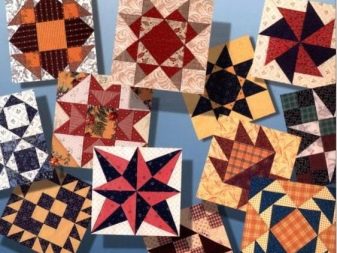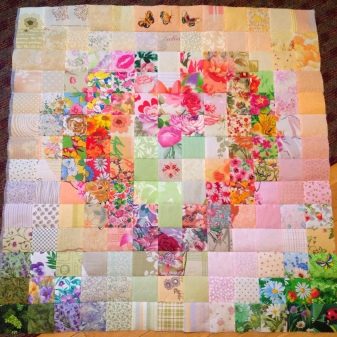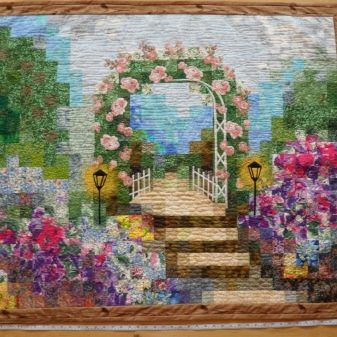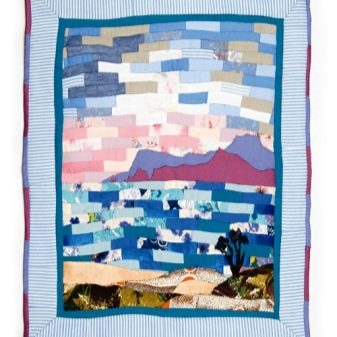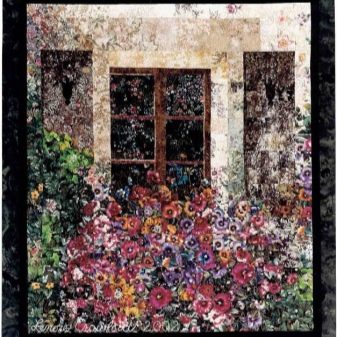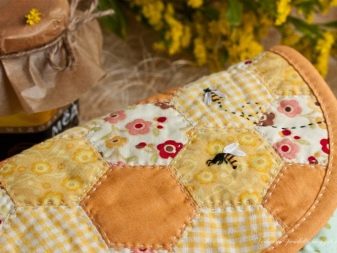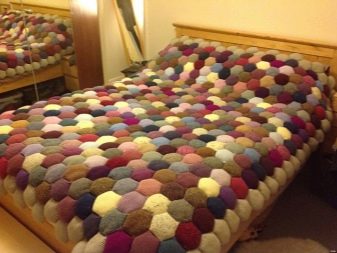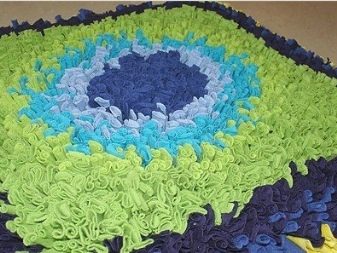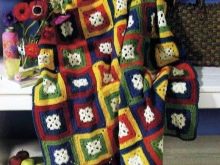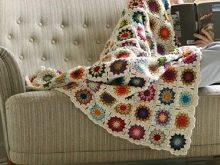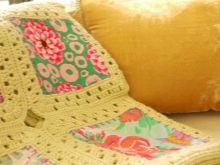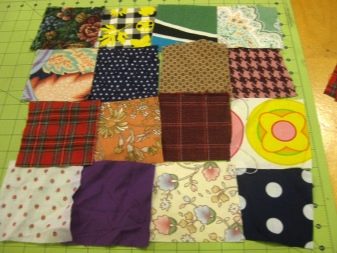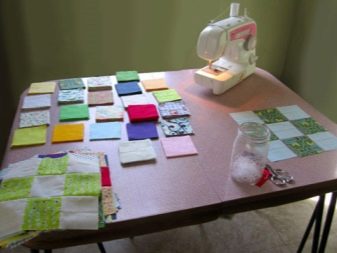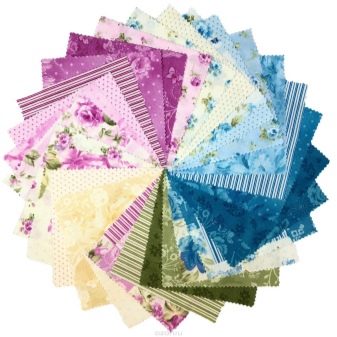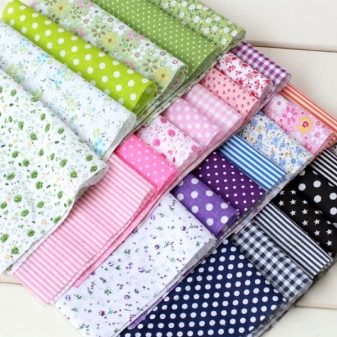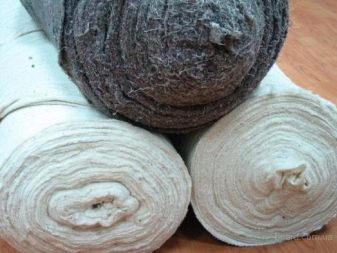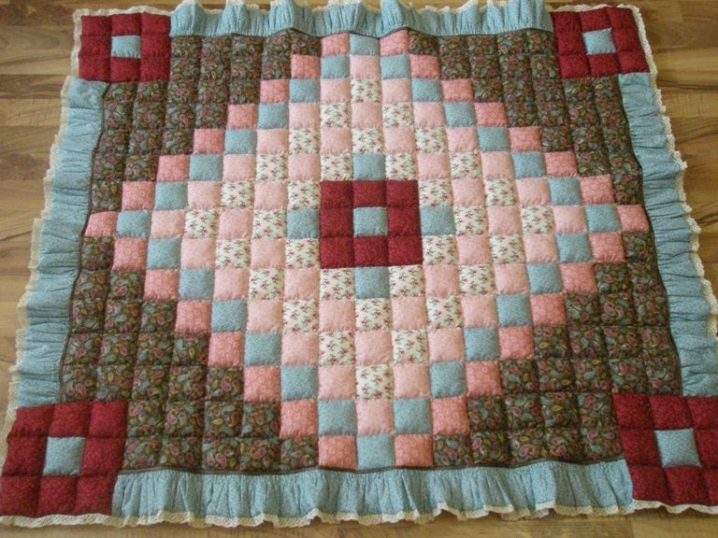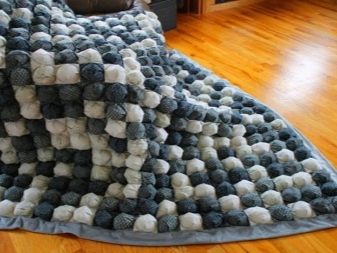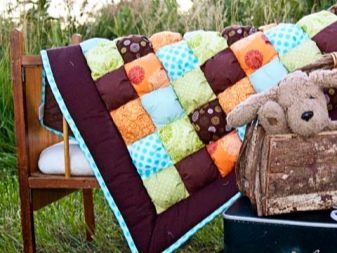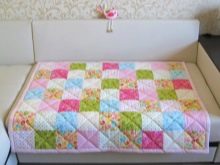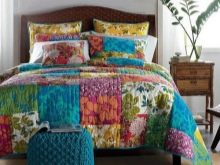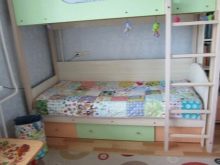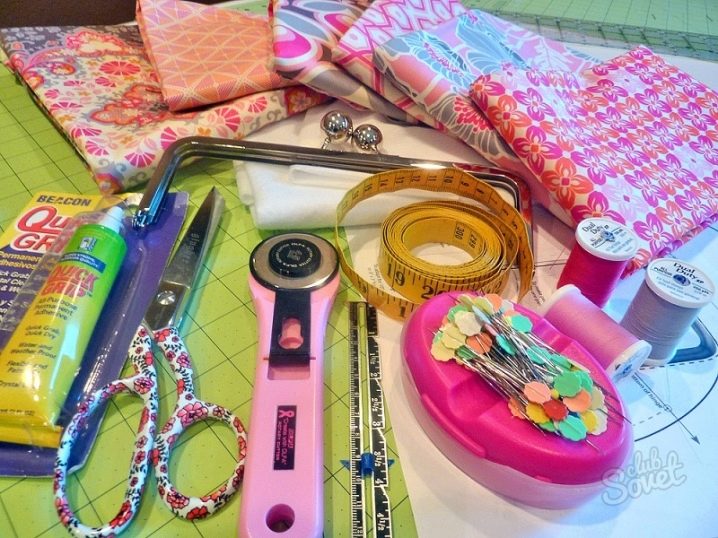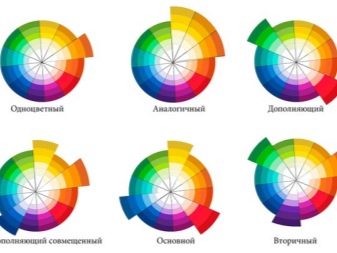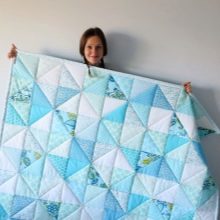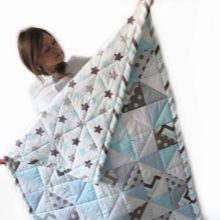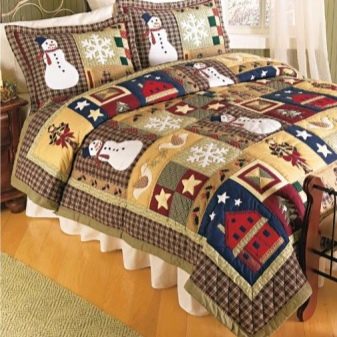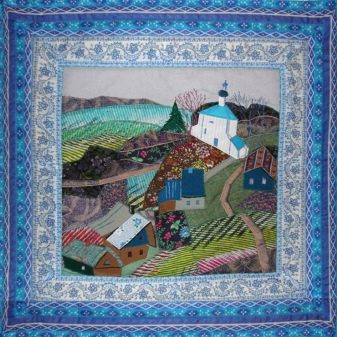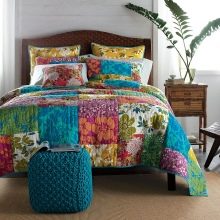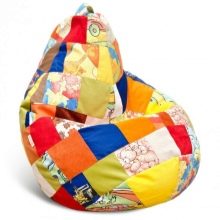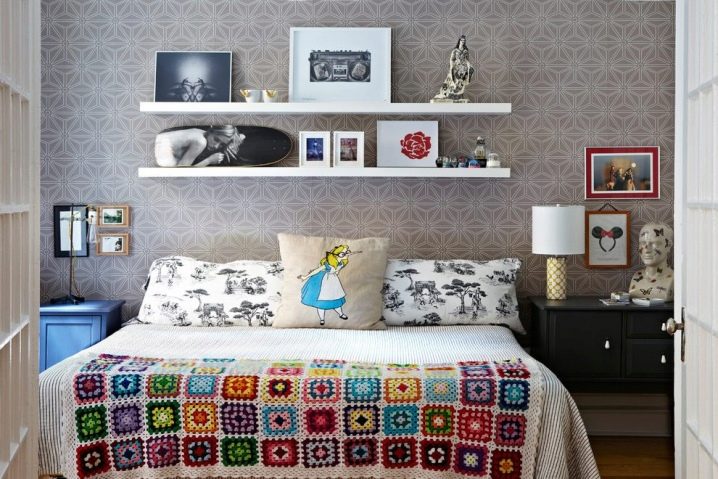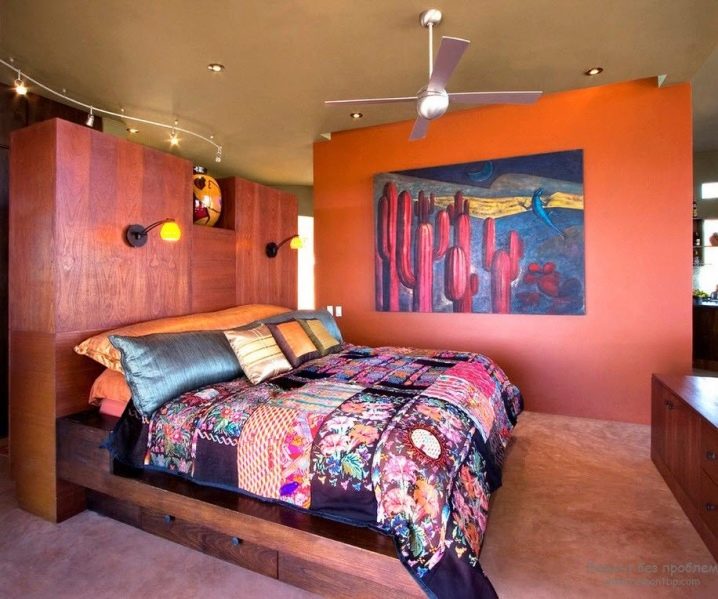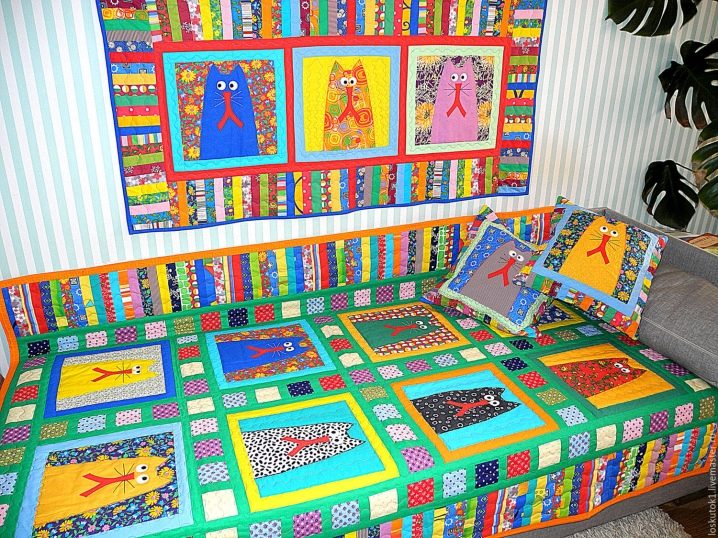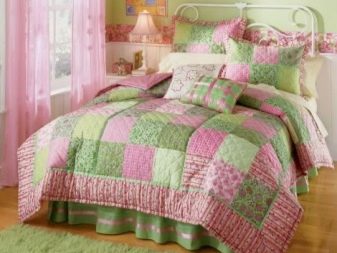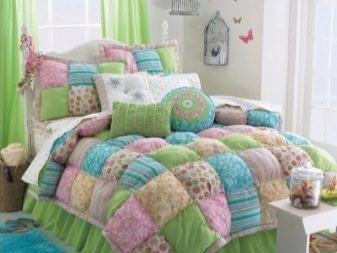Quilts
Since ancient times, mothers and grandmothers independently made blankets of patches that had an incredibly beautiful ornament and coloring. This skill has been preserved to this day. Today, to make a patchwork blanket on your own does not take a lot of effort, as there are sewing machines and special devices, so their production takes a minimum of time, and the result is simply incredible.
Features and benefits
Those who like to do handicrafts and make things with their own hands always have pieces of cloth that are a pity to throw away, and in order to sew something together they lack the same material. But do not worry, there is an opportunity to create a beautiful and unique blanket cover in a style called patchwork.
This applied art was from the time of ancient Egypt, women took rags and created something beautiful with their own hands. Some scientists claim that this style of sewing appeared much earlier in the East and in Japan. There were leather and fabric products, dating back to the IX century BC. er
Later in Europe, this trend in sewing "born again." When the time of the Crusades began, with the help of patches, canvases and flags were created that were so necessary. But most of all, the residents of the UK appreciated the patchwork style, as it helped to save on material, and in the end it turned out a worthy product. Plus, the British craftswomen were able to come up with a wide variety of patterns and ornaments that are embroidered to this day.
Such blankets and bedspreads, as mentioned earlier, have been sewn since very ancient times, due to the lack of an alternative. To create them, you can take monochrome or multi-colored pieces of materials. Stitched together, they create a unique pattern that will add comfort and a good mood for each day.
The peculiarities of this product is that it consists of assorted cuts of fabric, which have the same shape and are sewn together.Thus, it creates a large canvas, which you can hide or decorate the room.
Also, a quilt is usually made without an inner filler, so there is the possibility of performance from thin and delicate materials, such as tulle, silk or satin.
The patchwork canvas has several advantages:
- To create it does not need extra spending or large investments. Absolutely all fabric leftovers or old t-shirts and jeans will go.
- You can’t meet and see the absolutely identical patchwork quilt; it’s safe to say that this is a designer thing in a single copy.
- In the process of making it, you calm down and enjoy your work, which always has a beneficial effect on your mood and inner state.
- The created blanket will be no worse than the store one, it will always warm you perfectly, and it will also be an excellent cover on the bed.
- Such a quilt can be made of any size, which greatly simplifies the situation when, for example, there is a large non-standard sofa, and to sew a cover to order is very expensive.
Kinds
From fabric cuts you can sew not only a high-quality and warm blanket, but also many other things that will be able to decorate the house, as well as make the interior unique and unforgettable.Often, if the skilled workers make a blanket, they make a whole set with pillows. Thus, the room is filled with comfort, home simplicity and softness.
In itself, such a product can have many purposes, so many varieties appear.
For example, if a quilt is intended for decorative purposes (to serve as a blanket on a sofa or bed), it can have a very unusual application, which is made based on a fairy tale or a beautiful story.
For children's rooms, thematic patchwork patterns are often made, for example, for a boy’s bedroom - this can be a boat, a horse, a car, and for girls flowers, dolls, kittens, etc.
Plus, moms make soft bedside rugs for their children to make them comfortable to get up in the morning. And for very small crumbs they make interactive patchwork carpets with walkways, stones, flowers and a lake. Thus, a whole playing field is created, in which it is sometimes interesting to play by adults as well.
Very often they make a bilateral blanket, which, on the one hand, can have winter motifs and colors, and on the other hand, summer ones.So, depending on the time of year, you can change the atmosphere in the room.
As a rule, a quilt can perform not only a decorative function, but also a practical one. Very often needlewomen make a rather simple, warm and voluminous blanket that will warm even in very cold winter nights.
In the patchwork style do not only blankets and pillows, but also many other amazing things. For example, avid lovers to sew something on their own, make incredibly beautiful envelopes for discharge from the hospital. For a girl, it can be made in pink, peach colors, and for a boy in blue or green. This fantasy is not limited. From the rags do various napkins, glass holders, even the curtains on the windows.
In this style, you can do not only things, but also to decorate the wall. There are a large number of schemes for sewing panels or envelopes for newspapers or magazines.
The most important thing is not to overdo it in decorating a room with such things, otherwise the room can be full of colors and it will be uncomfortable to stay in it for a long time (especially for the bedroom).
Some patchwork lovers make clothes for themselves in this technique (skirts, pants, t-shirts).
Styles
Even at the stage of planning and planning the future patchwork product, it is necessary to consider its size and the style in which the work will be performed. This is very important, as there may be a conflict of patterns and textures. Patchwork products are most often suitable for rooms made in the style of Provence, Country or Scandinavian, but with the right choice of colors, material and ornament, such a patchwork can successfully fit into the style of minimalism and high-tech.
To date, there are a large variety of areas and themes in the design and manufacture of patchwork blankets. As a rule, each style adheres to a specific idea and color range.
Mostly distinguished classic, oriental, custom and knitted styles.
Classical
In the classical direction it is necessary to observe the clarity of forms and calm, and even in some details a conservative approach to the choice of color. There is no great emotionality and rampage of shades and colors, very often this combination of 2 to 5 colors is not more. As a rule, flap shapes are square or triangular.
Custom
In a non-standard or crazy direction, all the variety of ideas is observed, as well as an abundance of decorative elements.Flaps can be of different shapes and sizes, very often they sew beads, beads, or buttons. It may seem that this is a rather chaotically made product without following the rules on the compatibility of colors, but often the general idea or pattern is visible through the use of decorative elements.
For example, for a little boy in a crib, an excellent solution would be to make a quilt in a nautical style, where blue-green shades will dominate, as well as an anchor shape, maybe even a ship. It is always interesting for a child to look at such a blanket, and also to touch the sewn buttons or decorative knots.
In this style, you can perform and "rustic" patchwork. It is sometimes distinguished by incompatibility of colors or the dominance of green, earthy or red-maroon shades. Moreover, the pattern on the patches themselves can be as ordinary peas, and "Indian cucumber."
Oriental
The eastern direction in the patchwork style is due to the presence of more refined fabrics (silk, satin), and also has some similarities with the classical direction. There are golden, ocher shades, silver and metallic.Also, there is a fringe around the perimeter of the edge or tassels at the corners.
As for the ornament, then small details and a small pattern on the fabric itself predominate. Most often in this style they make not only blankets, but also napkins, pillows. They are very beautiful complement the interior, making it more refined and sophisticated.
Knitted
Knitted patchwork is a very original style, as it combines the simplicity of forms and soft texture. Craftswomen who can knit and crochet, are advised to take a thread of acrylic and wool, mixed with each other by half, and also that it was the same thickness. Such a product is unpretentious in use and cleaning. It will be very voluminous and warm.
Skilled craftsmen can knit various motifs on individual squares, for example, New Year's or dedicated to Valentine's Day, Easter, etc. These can be all kinds of snowflakes, deer, hearts of different colors, angels, Easter cakes and much more.
Techniques
Today, there are a huge number of ways to create quilts and not only:
From the bands
Perhaps the most common and simplest option is the technique of stitching long andthe same width of the bands. Such a blanket will resemble a brick fence, especially if you choose a color.
Well
One of the old techniques of creating a unique pattern is the American square or well. This style of sewing was very popular two centuries ago in America and, accordingly, in Europe. At the heart of this ornament is a square, which is sewn from strips, gradually increasing in length. Thus, the illusion of a well from logs is created, if you look at it from top to bottom.
There are several options for creating such a pattern.
- At its base and at the beginning is a square, which is sheathed with a strip of fabric on each face, with each subsequent “log” sewn overlapping each other in a circle. The bands can increase in width or remain the same, the main thing is to change the shades of the tiers, so that the effect of the volumetric well is. You can also make a dark middle, and closer to the edge sew lighter flaps.
In order not to confuse what color of the fabric comes next, it is better to pre-sketch the future product and number the “logs”. So the easiest way to prevent mistakes when stitching.
- The second technique of creating an American square is also based on the square, which is the core and the foundation. Pre-cut and processed patches, sewn on each side by the type of ladder. It turns out that the cuts of each side touch each other at the corners. Here, too, it is worth remembering about the color transition in order to preserve the visual effect.
Do not forget that in this technique, you can also experiment, it can be both color, shape, and the shift of the center, to any of the edges, so that you get a unique design.
Of squares
Stitching squares is one of the most ancient and simple ways to create a patchwork quilt. They can be large, medium in size or reach up to 1-4 cm in area. The main appearance of the pattern creates a color and a sequence of stitching patches. The ornament can have 2 colors and resemble a chessboard, but the variant with a wide variety of color palettes looks more interesting. Some masters are able to create portraits from rectangular cuts, resembling a pixel photograph.
The basis of the stitched pattern can be taken by any geometric figure, for example, a triangle.It is very easy to work with him, because of it you can make a rectangle, the same square and even a circle or a rhombus.
For work, isosceles triangles are most often cut out (it is very important to ensure that the direction of the threads in the fabric is in one direction).
The most common ornaments made from this figure are the "mill", "star", "flower".
Watercolor
A very creative is watercolor technique. The product can be made of patches of different shapes (squares, rectangles, etc.), but the most important thing is color. Cuts are selected in such a way that the tones are approximately in the same color range. In the sewn, finished form, this canvas resembles a canvas, on which they painted with watercolor. Such rugs look very gentle and airy.
Of hexagons
Very close to nature is the technique of "honeycomb". For this, hexagons are cut and stitched together, and more often, the whole blanket is made of beige or light patches, and only some hexagons are made of honey or yellow color so that it does not look too bright. You can sew small bees on top for more atmospheric products.But such a figure is not always used to imitate cells, very often hexagons can be multi-colored and lay out a whole, bright product.
"Lyapochiha"
One of the most beautiful and voluminous patchwork techniques is called "Lyapochikh". If you have accumulated a very impressive amount of old and unnecessary knitted T-shirts or T-shirts, then an amazing patchwork quilt can be made from them. First you need to buy a fabric on which everything will be sewn. Then things are cut into patches (it is desirable that they are rectangular) and, without processing the edge, they are sewn layer by layer onto the substrate.
To make the product more voluminous, cuts can be screwed into tubes. The result is an amazing and colorful patchwork quilt or something else.
If you disassemble the cut pieces of fabric by color, then you can lay out a picture or pattern. Most often they make flowers or imitation of sheep wool or fish scales.
All other techniques of creating ornaments come from the above. The interlacing and stapling of the patches alternate, as a result of which a colorful and original design can be obtained.
An interesting solution would be to make a blanket or blanket crocheted in a patchwork style.Thus, you can link a very beautiful ornament using a variety of colors. Usually, wool, acrylic or a mixture of them is used. But the most interesting thing is that as a thread you can use finely chopped and bonded tissue residues. For such knitting will have to use a larger hook.
Materials
In order to sew a quality quilt that will last for many years, you need to think in advance about what material to use. Usually skilled workers take the remains from former projects and tailoring, thereby saving money and time for searches of fabric. It can be patches from old jeans or from children's things from which the child has already grown.
But be aware that not all fabrics are suitable for stitching with each other. For example, if you sew a blanket of cotton and knitted patches, it will be inconvenient, since the knitwear is strongly stretched and the bevel of the seams can go.
Fabrics are divided into artificial and natural.
Of course, it is always better to give preference to quality linen, cotton or silk, but these materials are not cheap, so they are often replaced with synthetic cuts.
Recently, you can find in the store special patches for patchwork. As a rule, they are made of 100% cotton. Such matter will not fade, wash up and "sit down" from washing. It is also made of polyester or synthetic fibers.
It is very convenient that the material for sewing is sold with flaps, so you can take the required number of cuts of different colors and pay relatively inexpensively.
In order for the patchwork to be warmer, airy and textured, the craftsmen use a special padding material between the upper and lower layers of the flaps. It is also called insulation or filler.
It is very important that the thickness of the inner lining is not too large, otherwise the stitched patches can be quite hard or bulky.
Such insulation is easy to find in fabric stores, rolled into rolls. Like a regular canvas, it is also sold by the meter.
The filler is made of various materials that have special characteristics:
- If it is made of cotton, wrinkles may appear after washing on a sewn blanket. But the plus will be his ability to "breathe" and let the air through, which means inside, moisture will not linger.
- There is an improved option - a mixture of polyester and cotton.This layer sits well, without tightening the material, and keeps warm well, which is very necessary in winter.
- A pure polyester pad is an easily accessible material that is not subject to moth or mold attacks. Due to the fact that it is an artificially created fiber, it does not let the air through and at the same time is very elastic and has a low weight.
- Very often, flannel is bought as a heater. It is a rather thin and durable material that has poor elasticity, which makes it difficult to tailor a quilt for inexperienced and beginner craftswomen.
If it was conceived to sew a warm enough blanket, then it is better to purchase wool filler. The product will be slightly voluminous, but thanks to this, under such a blanket will be very warm and comfortable. It is also easy and comfortable to work with such a filler both manually and on a sewing machine.
Dimensions
Blankets for beds come in completely different sizes, but there are standards, as with sheets and duvet covers. There are children's, one and a half-sleeping blankets, double (there is a kind of euro - double) and non-standard, which are sewn and made to order:
- Usually, blankets for children have a width of 110 cm and a length of 140 cm, and for newborns they are usually square - 120 by 120 cm or 140 by 140 cm.
- One and a half plaids may have a width of 135-140 cm, and a length of 200-210 cm. This option is suitable for one person or for a couple sleeping on a small sofa. As for the euro variant, each parameter is increased by 10-15 cm.
- Double models have dimensions of 170 by 200 cm or by European standard 200 by 220 cm. As for large and non-standard blankets, sizes can start from 220 cm in width and 250 in length.
Based on the required size of the future product, it is necessary to calculate the number and parameters of the flaps, as well as their shape. Do not forget that the smaller the stitched cuts, the harder the quilt will be and vice versa. Of course, on a large product it will be more beautiful and aesthetically pleasing to look like a square or a triangle of medium size, and also it will save time on its production.
Small parts are more suitable for small or children's blankets. Of these, it is easier to make a high-quality ornament or a figurine of your favorite character or animal.
Colors and patterns
As a rule, a patchwork quilt is distinguished by its frivolousness, and sometimes by excessive riot of colors.Therefore, in order for the finished product to look aesthetically pleasing, you must first select a pattern in which the meaning will be seen, and also select the necessary colors. Skilled craftswomen in this industry select colors intuitively, they are able to find the right shades and correctly combine them with each other. Of course, everything comes with experience, but where to start?
To get a beautiful result, you should familiarize yourself with the basic properties of the color, namely refer to the color circle, with which it is easy to identify compatible and incompatible colors.
After all, color, in the first place, conveys the general mood of the originally conceived creative pattern. If the material palette is chosen incorrectly, then an overly multi-colored blanket may turn out to be annoying with time. The color choice should be harmony.
The most important thing is not to overdo it with the color variety, it is best if 1 or 2 primary colors are chosen for the main ornament or pattern, and the remaining 2 or 3 colors will be background and less bright in comparison with the main ones.
There are also special programs to help novice cutters and sewing lovers who will quickly help you find the right color scheme (one of the most popular is ColorLab).
The drawings on the product can be either with a regular geometric pattern, or with a solid plot.
Most often they sew from square, triangular or polygonal patches, since this method is much easier. With the help of such figures you can make a blanket with stars, with multi-colored flowers, diamonds or simply - in the form of a chessboard.
Recently gaining popularity schemes with animals, birds, fish. If a patchwork is made for an exhibition or, as a decoration for a house, then entire plots from fairy tales or favorite books can be taken as a basis, as well as the ancient mosaic layout of ancient times.
High-level craftsmen can perform work of a complex order, so you can find products in the style of patchwork on religious themes. It can be various faces of Christian saints or ancient gods. It looks very beautiful, and most importantly - such a masterpiece will decorate any room.
The main thing is to have patience and do everything neatly step by step, then each finished work will please not only with its beauty, but also with warmth for many years.
The best ideas in the interior
Of course, the quilt is one of the elements of the decor in the room, so you should be careful with its tailoring, choosing the best colors and materials.
For small rooms, patchwork blankets, made in bright, light colors, are suitable, so the bed will not seem large, but, on the contrary, very compact. An excellent addition to the interior will be the same cushions and chair covers, if they are in the room. Often made of flaps bean bags, they look very interesting in the room, and also delight with its practicality and softness.
If it was decided to make a blanket of patches in the living room, then you need to proceed from the general atmosphere. For example, the room is decorated in the style of Provence and has enough free space, then you can create a volume in turquoise-pink shades, as well as make the same pillows that can be expanded into separate chairs, creating a complete picture. The blanket can also be made in the technique of watercolor or a chessboard.
As can be seen from the interior of this bright room, the knitted patchwork bedspread perfectly complements the space, and it does not distract much attention to itself, leaving the room very calm and harmonious.
Despite the large abundance of colors in the quilt, they are very harmoniously combined with the overall situation.The room disposes to complete relaxation and beautiful sleep.
This example shows that the bed is full of bright and bright colors, so it will be difficult to calm down and sleep here.
Shown here is an incredible sense of style. The blanket is sewn in such a way that it is combined with the whole decor in the room, and there are also curtains made in the same style. Despite the fact that there is a lot of patchwork in the room, it does not seem pretentious. This is achieved due to the color and texture of the fabric itself.
How to sew a random color quilt in 30 minutes, see the next video.
